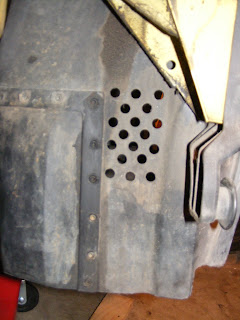 The G60 Corrado is equipped with an intercooler. It is essentially a radiator about the size of a small shoebox and is located in the lower front bumper on the drivers side of the car. In the illustration above, one can see that the air flows through the high pressure area in front of the airdam and flows through the intercooler located on the lower right.
The G60 Corrado is equipped with an intercooler. It is essentially a radiator about the size of a small shoebox and is located in the lower front bumper on the drivers side of the car. In the illustration above, one can see that the air flows through the high pressure area in front of the airdam and flows through the intercooler located on the lower right.To understand why an intercooler is necessary one must understand a little bit about the physical properties of air. A volume of air will carry a certain amount of thermal energy. If that same volume of air is compressed into a smaller space, the heat energy of that volume of air is more focused because the energy has not been dissipated. It has been confined to a smaller space therefore raising the temperature of the compressed air.
Air at higher temperatures does not contain as much oxygen and the same volume of air at a lower temperature.
What all this means for the corrado owner is that once air passes through the glader and is compressed, it has a higher air temperature. The compressed air then passes through the intercooler allowing it to dissipate the thermal energy thus lowering the temperature of the air entering the combustion chamber. This adds up to more efficient combustion and more horsepower.
On a warm day at freeway speeds, the corrado intercooler can lower charged air temperatures by 75F-100F. At lower speeds the effectiveness is diminished.
The more efficiency we can get from the intercooler, the better. Short of adding a larger intercooler, we can improve airflow through the stock intercooler. This can be accomplished easily and cheaply.
As mentioned earlier, the intercooler takes air from the high pressure zone in front of the bumper on the drivers side. That air flows through the intercooler and exits out the back. However, the wheel well liner sits directly behind the intercooler. Therefore the air exiting the back of the intercooler hits a flat wall and therefore prevents effecient flow through the intercooler.
 This can be remedied by opening up the wheel well liner in the area directly behind the intercooler. What you are looking at is the front of the drivers side wheel well liner as viewed from the front. The purpose of creating a ventilation opening is to allow the air to flow freely through the intercooler and out into the wheel well space.
This can be remedied by opening up the wheel well liner in the area directly behind the intercooler. What you are looking at is the front of the drivers side wheel well liner as viewed from the front. The purpose of creating a ventilation opening is to allow the air to flow freely through the intercooler and out into the wheel well space. Drilling is easily accomplished. I do not recommend cutting large holes as the rotating tire does deposit a lot of flying debris which can damage the thin fins on the intercooler.
I drilled 1/4" holes in a grid pattern which opens up the port but creates a grille which will as serve to protect the intercooler.
This is an inexpensive and effective modification that mimics some of the newer cars who do the very same thing. In this view which is taken from the side looking into the drivers side wheel well. The brake rotor is visible to give you a reference point of where to make the ventilation holes. This should help make the OEM intercooler a little more effective. And any little improvement will make a difference--especially if the extra power can be obtained for free! 

Comments